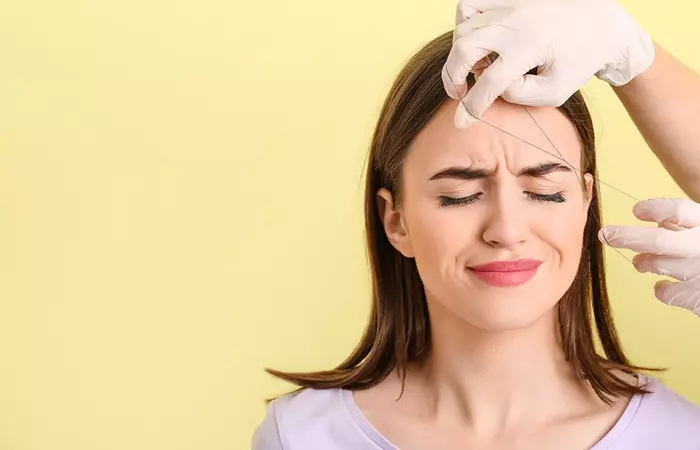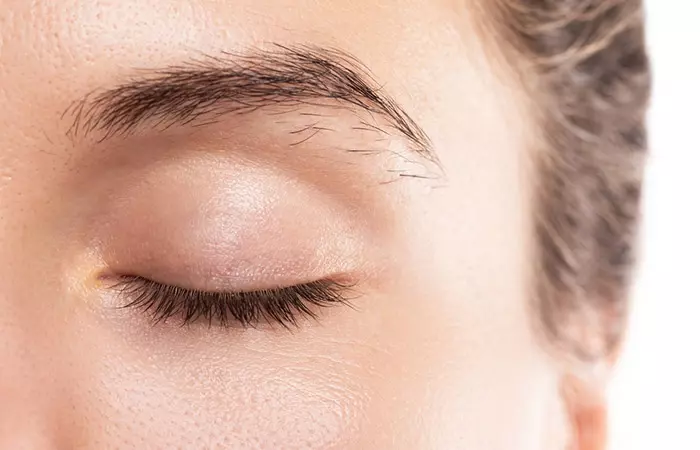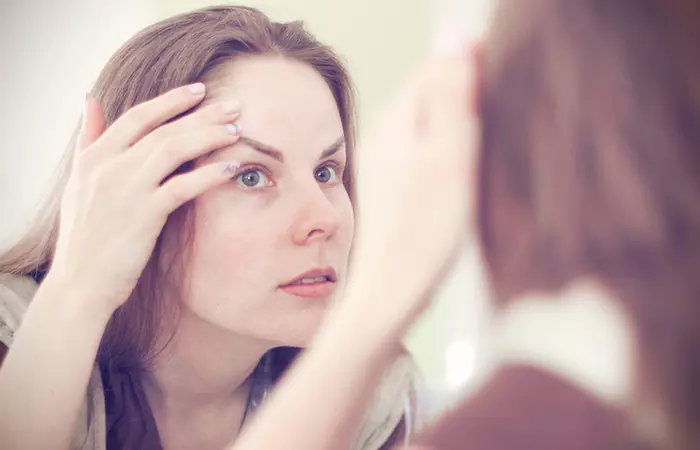Waxing involves using a wax strip to trap the hair and pull it from the roots. On the other hand, threading involves removing the hair by tugging it out of the follicles with a thread. Read this article to understand the difference between the two and learn which one is better. Keep reading!
What Is Eyebrow Waxing?
Eyebrow waxing is a century-old procedure where a beautician smears heated wax on the desired area using a wooden stick or knife. It is then covered with a paper strip and smoothed and pressed onto the waxed skin before being removed quickly. Eyebrow hair is ripped from the roots, resulting in a smooth and soft finish.
Pros And Cons Of Eyebrow Waxing
Waxing is a quicker and more effective process than other eyebrow shaping methods. It can also provide a sharper and cleaner shape than threading. Waxing is the ideal approach to manage your brows if they are extremely thick and bushy. However, since the wax is applied directly to the skin, it may irritate a person with sensitive skin. Also, the wax might contain resins, preservatives, and synthetic fragrances, which can cause adverse reactions, such as rashes or itchiness. If the damage is severe, the skin may become excessively pink or red. The skin may also bleed. Moreover, if the wax is extremely hot, your skin may get burned, resulting in pain, irritation, and scabbing that can take weeks to recover. The irritated or burnt area may leave a long-standing mark as well which may be difficult to treat. Repeated waxing may strip off skin barrier, making it sensitive over a period of time, resulting in thinning of skin and early aging. Note: Waxing is not recommended for people who are undergoing chemical peels or have highly sensitive skin. If you are getting your brows waxed, make sure you get it done by a skilled esthetician in a trusted beauty salon.
What Is Eyebrow Threading?
Eyebrow threading is a fairly simple process in which the esthetician discuss their skin type, the desired shape of their brows, and the hair texture with their clients. This is followed by sanitization and cleaning the eyebrow region to be threaded. The client is asked to close their eyes and actively tighten their skin during the procedure. Then, the esthetician twists a cotton or polyester thread into a triangular loop and plucks eyebrow hair from the follicles. The thread grabs unwanted hair and pulls it out, providing the correct shape and appearance to your brows.
Pros And Cons
Since threading involves little or no contact with the skin, there is less possibility of developing an allergic reaction . If your skin becomes red or sore after threading, it will usually go away within an hour. Also, there is no risk of inflammation or burning sensation in this method. Threading is particularly suitable for people with sensitive skin because it does not involve chemicals or heat, making it less likely to cause an adverse effect. It allows greater precision, so there is less possibility to find those little hair strands after threading. However, threading may not be the best option if you want a more sculpted and edgier eyebrow look. It produces a natural shape rather than a sharp pointed one. Threading can be extremely painful or even cut the skin if not done the right way. Pro-tip: Always ascertain with the aesthetician that a new thread or a clean sterilized knife and wax strips are being used to shape your eyebrows and the technician’s hands and fingers are clean and without any infection. Viral warts commonly spread during waxing or threading.
Which One Lasts Longer: Waxing Or Threading?
It is important to note that neither waxing nor threading is a permanent solution . However, both hair removal procedures usually last for a month. Since the rate at which eyebrow hair grows varies from person to person, you should wait at least 3-4 weeks before doing any maintenance or scheduling another brow session. Also, enable the hair to grow bigger; otherwise, it might be too short to work with. In rare cases, threading can result in faster hair growth if the hair is only split off and not completely removed from the root. Scroll down to find out if threading is more painful or waxing.
Is Waxing Or Threading More Painful?
Let’s be honest, both methods cause some pain and discomfort. However, most people claim threading is more unpleasant than waxing. This is because waxing removes more hair at once, whereas threading removes hair with each passing of the thread. Therefore, waxing is less painful than threading since waxing eliminates hair in patches rather than rows. Although threading provides the cleanest finish compared to any other method, it comes with much discomfort. If you want a more accurate outcome, forget the pain and go for threading. However, if you cannot bear the pain, go for waxing. Follow these steps before getting your eyebrows threaded or waxed.
Things To Do Before Getting Your Eyebrows Threaded Or Waxed
Before Threading Before Waxing Still wondering which is better between waxing or threading? Find out in the next section.
Waxing Vs. Threading – The Verdict
Both threading and waxing are ideal methods to achieve your desired eyebrow shapes. They can work well for you based on your lifestyle or skin care needs. So, none of them is a clear winner here. Both methods produce excellent results, and, choosing between the two comes down to personal preferences. Threading is a precise and less expensive approach, but it is more time-consuming and requires a higher level of pain tolerance. It is the best option for people with sensitive skin and who have had skin peels recently. On the other hand, waxing is a less painful alternative and ideal for getting rid of extremely thick brows. Although a bit costly, it can offer you a sharper finish and allow you to experiment with unique brow shapes. Dania Denise, a model and a blogger, wrote about her preference of threading her brows over waxing them. She said, “I started waxing some years ago and while it provided some relief, I still had to deal with my curly hairs and a lot of missed strays. Ever since my first threading I have never gone back to waxing (i).” Does hair grow thicker after threading? No. It has been observed that threading removes the hair from its roots. This process, if repeated, may result in finer hair over time. Can threading cause wrinkles? Possibly not. There are no scientifically proven studies stating that threading can lead to wrinkles. Does waxing reduce hair growth? No. While it is possible that frequent long-term waxing may lead to the formation of fine hair, it may not affect the inherent hair growth cycle. Is it normal to cry during eyebrow threading? Yes. Threading adds extra pressure to the sensitive area around the eyes. This may lead to tears. Does threading damage hair follicles? Possibly. As the hair is pulled out from its roots by threading, the follicles may be damaged. Does waxing darken skin? Possibly. The process of pulling out hair or the hot wax may cause post-inflammatory hyperpigmentation, which causes pigments to be produced that darken the skin.











